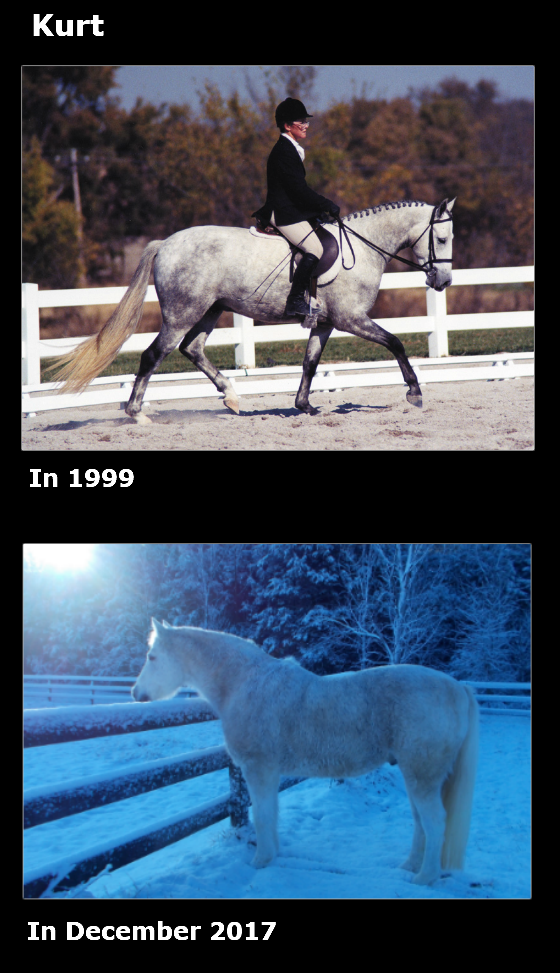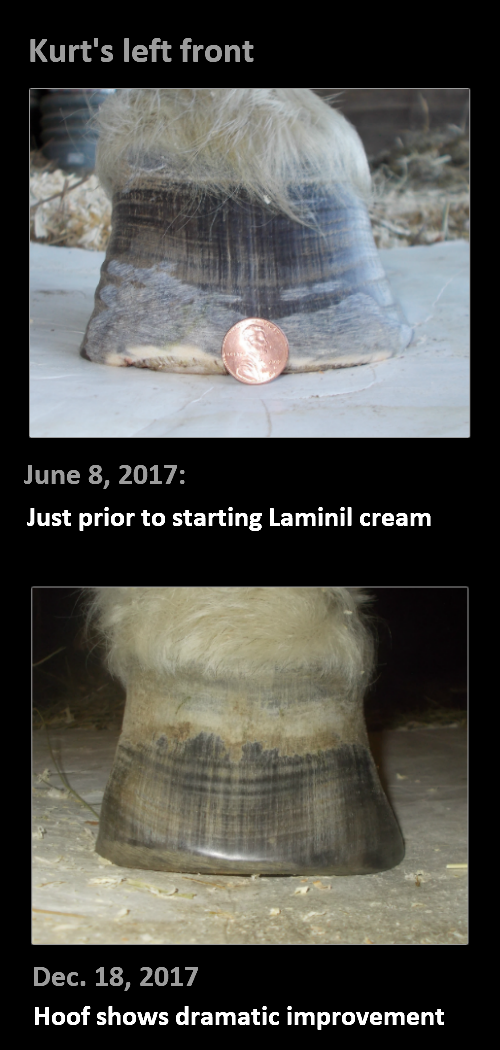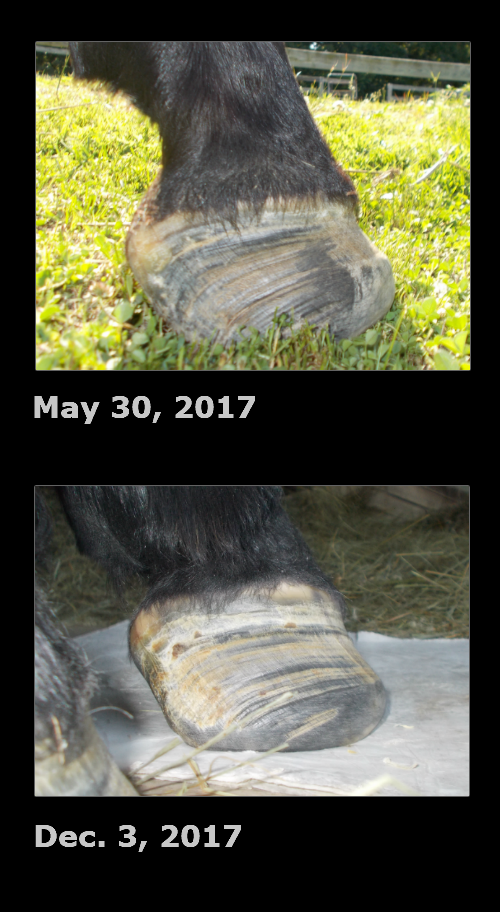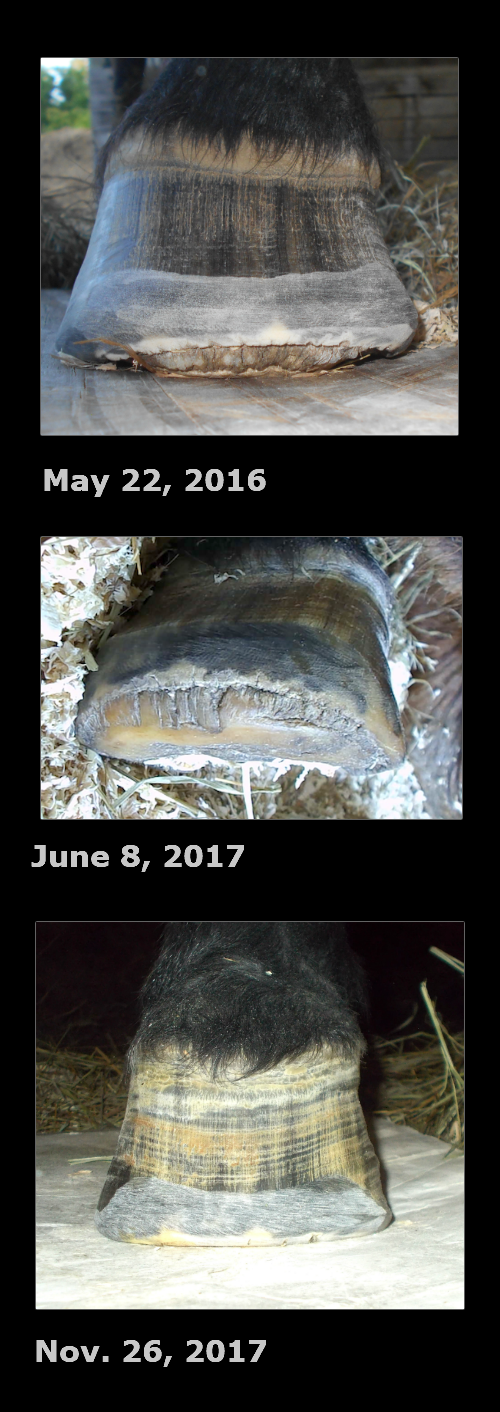How Laminil helped my laminitic horses
Robin and Kurt gallop Dec. 26, 2017 (Kurt, the white one, is barefoot, while Robin is in boots; both are bute free)
Post reviewed Nov. 26, 2022
I finally got to try Laminil cream on my horses’ laminitic feet beginning in June 2017, and the improvement is dramatic.
I’m using it on my last two horses, both geldings that turned 22 in 2018.
Laminil has stopped the laminitis and allowed my horses’ feet to heal in the most extreme of weather conditions, both hot and cold, and in horses that are severely insulin resistant.
Robin Hood was diagnosed with laminitis around 2006, and his feet have suffered a lot of damage as a result.
Here are his available X-rays from his left foot.
Kurt has been plagued by laminitic abscesses since 2010, and his refined body has gotten quite lumpy in recent years, revealing his endocrine issues.
Thanks to Laminil cream, both horses are now off bute. That alone feels like a miracle. The horses are standing all the time and moving around comfortably, even being playful.
In June 2017, prior to Laminil, they were on 1 to 1.5 grams of bute, primarily to ease pain in their back feet (boots don’t seem to fit the back feet well). Robin Hood (the bay) was uncomfortable even on that amount of bute. In most of his pre-Laminil video, he is lying down and looks miserable.
Pre-Laminil: Robin stays off his sore feet June 7, 2017
Pre-Laminil: Robin walks in shavings June 6, 2017, with 1.5 grams bute
Pre-Laminil: Robin walks June 8, 2017, with 1.5 grams of bute
Kurt responds well to bute if he isn’t on it for long stretches, and he looked fairly decent in his pre-Laminil video on a gram of bute, but photos of his feet told the real story. Ignore the penny in the image below. It was intended as a measuring device, but it didn’t seem necessary in the end.
Kurt’s feet before and after Laminil treatment
Now (Jan. 27, 2018), Kurt is pasture-sound and barefoot.
As you watch the videos below, note that the horses are 22 and haven’t been asked to do anything in years. When I asked Robin to trot, he said, “What?”
Post-Laminil: Kurt walks without any bute on Jan. 26, 2018
Post-Laminil: Robin walks Jan. 26, 2018, with no bute and no boots
Below are PDFs of the front feet showing the changes in the horses’ feet. I originally took photos every week. It’s very time consuming. Now, I do it every other week or when I can. I also am doing timelines of the back feet.
PDF: Kurt’s right front through January 2018
PDF: Kurt’s left front through January 2018
PDF: Robin’s right front through January 2018
PDF: Robin’s left front through January 2018
I like to follow the left photo in the PDFs as I scroll down. Note that the stretched white line at the toes has closed; the hoof wall is starting to meet the ground at the toes, the hoof walls all the way around, as seen from the bottom, are thicker and stronger; longtime abscesses are finally healing; and more normal sole is growing. And how did I suddenly get bars to grow? Laminil gets all the credit for that. The feet have had almost no bars since 2013, when I started trimming them.
If your farrier or vet is puzzled by my trimming, the answer is that I have no training, though I try to follow the ELPO trim. I don’t pretend to be an expert or even good. I’m terrified. But I trim at least every other weekend to keep the feet from growing out of control.
Robin Hood’s inside walls have been collapsing in recent years; those are now straightening out.
Robin’s left medial (inside) hoof wall is straightening out
Robin’s stretched white line at the toe is healing (this is the right front)
The horses came through the brutally cold winter of 2017-2018 in Missouri without losing any ground. Temperatures near zero have set off many “winter laminitis” bouts for them in the past.
The horses galloped through a little snow on Dec. 26 (see video at the top of this post), which was really fun to see. I hadn’t seen them trot for months, much less gallop. What isn’t obvious in the video is the wind chill was zero. I took the video from inside. The ground was frozen, even with the snow. Near-zero and sub-zero temps continued for two weeks. And another week of brutal cold set in a week later.
The horses are getting a dab of Laminil cream on the front and back of their hooves at the coronary band every other day. Originally, I was putting cream around the whole coronary band to address their laminitis bout in June. Now, this lesser amount of Laminil cream continues to foster healing.
Note that their feet have continued to heal even as their insulin resistance worsened from May 2017 to now. I’m totally failing on that front. I can’t find low-iron hay consistently now.
From the knee up, the horses look stressed.
From the knee down, they look good.
From the knee up, Kurt looks endocrine challenged
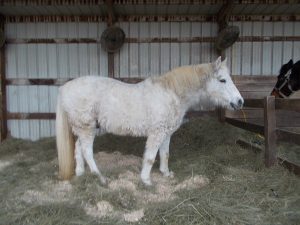
Kurt on Jan. 21, 2018. after three weeks of brutally cold weather. His hair and overall body condition appeared to worsen during that stretch, while his feet continued to heal.
Also, St. Louis had an extremely hot June and July 2017, with eight days of temps over 100 degrees and a record-setting high of 108 degrees. Extreme heat is also very stressful for laminitic feet. Yet, the boys’ feet kept improving during that time.

